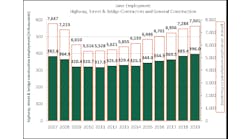By: Allen Zeyher
By the time this issue reaches readers, Air Force One carrying President George W. Bush might have been the first aircraft to land on the new runway 9L-27R at O’Hare International Airport. Chicago’s Mayor Richard M. Daley extended the invitation to the president, but when Roads & Bridges visited the construction site in mid-August, the president had not yet responded to the invitation.
Runway 9L-27R was on schedule to open on Nov. 20. The extension to runway 10L-28R went into operation on Sept. 25, 56 days ahead of schedule and under budget. The 3,000-ft extension gives O’Hare a 13,000-ft runway, which is needed for some bigger flights, such as flights to Asia that are fully loaded and fully fueled.
Adding the new 9L-27R runway gives O’Hare a total of three usable runways for arrivals in bad weather. These three runways are oriented east-west, which is the predominant wind direction in the Chicago area.
The new 9L-27R is part of the O’Hare Modernization Program (OMP). The goal of the program is to reduce delays for air passengers and reduce costs for air carriers.
“As all of you know, O’Hare is still one of the most delayed airports in the country,” said Rosemarie S. Andolino, executive director of the OMP, during a media tour of the project in August. “We are also still one of the world’s busiest airports. And the only way to solve that problem is with new infrastructure. And that problem will not just go away overnight with this new runway and the new extension. As we stated all along, in order to mitigate that problem of delay and congestion here at O’Hare, we have to build all the runways. They’re all necessary.”
The complete OMP calls for building four new runways, extending two current runways and closing three current runways. In the end, O’Hare will go from seven runways, with seven intersections, to eight runways, with only two intersections.
In the new configuration, O’Hare’s airfield should reduce average passenger delays from 24 minutes to 5 minutes.
What’s good for passengers also is good for carriers.
“If the entire program was built today, we had all the runways and fuel cost being what it is,” said Andolino, “we’d probably be able to save the carriers $400 million annually in reduced fuel costs, reducing the amount of time idling waiting to take off and circling waiting to land.”
The average delay should be reduced even though the airport is expected to add 300,000 annual takeoffs and landings. “That’s like adding Midway Airport [Chicago’s second airport] at O’Hare,” said Andolino. “It’s a major increase, and that’s by expected demand in 2018.”
All those takeoffs and landings must be supported by a sturdy, durable pavement. The pavement under O’Hare’s runways starts with a lime-stabilized soil sub-base.
Up, up and away
“Our subgrade is typically a lime-treated in situ material,” Jim Chilton, program manager for the OMP, told Roads & Bridges in a phone interview. “We have quite a bit of clay silt here, and for the most part, if we can provide some lime to it, we increase the strength of that material and we are able to pave right over the top of it.”
On top of the lime-treated sub-base is 6 in. of asphalt-treated permeable base, according to Chilton. “The purpose of that is to provide some drainage through there if we needed it.”
On top of the base sits another 6 in. of asphalt binder in a tighter mix.
The asphalt binder surface is coated with a bond breaker made of a waxy material, such as paraffin, to allow the asphalt below and the concrete above to expand and contract independently.
Finally, a thick layer of portland cement concrete goes down: 16 in. on runway 9L-27R, 17 in. on the 10L extension and, because it will take heavier aircraft, probably 18 in. on the planned new 10C-28C runway, which they have not yet begun paving.
OMP arrived at this concrete cross section through an analysis following Federal Aviation Administration (FAA) guidelines. The analysis factors in the expected number of loadings by passing aircraft and the weight of the loadings over the life of the pavement.
OMP will groove the new pavement to give the aircraft better traction. After about seven or eight years, the airport will have to regroove the pavement because of the wear from aircraft tires. Another seven or eight years later, O’Hare will have to overlay the concrete with 2 or 3 in. of asphalt, according to Chilton, and groove the asphalt.
OMP plans for a 20-year life span, said Andolino, but most of the pavement at O’Hare is over 30 years old.
The runways also are crowned, so any water drains off.
“We have some pretty wide swales in the infield areas so that water is taken away from the pavements and put into storm-drain systems,” Chilton said. “We certainly don’t want a lot of water hanging around any of the pavements.”
Into the wild green yonder
In fact almost all of the storm water that falls on the airport is collected by an extensive drainage system and collects in several detention basins around the grounds.
When Roads & Bridges visited the site, crews were excavating a new detention basin and recovering from a summer storm that dropped 6 in. of rainfall in six days.
“A few days ago, we had over 7 ft of water in this new basin,” said Weston Parker, lead resident engineer for the south airfield, during the August media tour.
The new detention basin occupies an area of about 80 acres and will contain 1,500 acre-ft of runoff from the nearby runways and other “hardscape.”
The detention basins at O’Hare are one component of the airport that is being governed by a new OMP sustainability initiative. OMP used the Leadership in Energy and Environmental Design (LEED) Green Building Rating System developed by the U.S. Green Building Council (www.usgbc.org) to develop their own Sustainable Design Manual. LEED is typically applied to occupied buildings, “but we still think there’s a lot of good initiatives that find its way into typical construction practices as well as other elements that we add on top of that,” Gene Peters, who was involved in developing the OMP Sustainable Design Manual, explained to Roads & Bridges in a telephone interview, and OMP is applying it to structures such as runways, electrical vaults and the new control tower. O’Hare has the first green roof on an air traffic-control building in the country. It is on the base building and the ComEd transformer building.
To build runway 9L-27R, OMP had to move a creek and demolish buildings that were in the way. They are recovering up to 90% of the materials from the demolitions and reusing them somewhere on the site. Concrete from demolished runways, for instance, is crushed and used on haul roads and service roads, although not as aggregate for new runways. Peters estimated that OMP saved millions of dollars in truck trips, fuel, pollution, etc., by reusing crushed concrete onsite instead of hauling it away and hauling in new material.
OMP worked with the University of Illinois and the U.S. Department of Agriculture to develop a seed mix that includes more native grasses that are drought-resistant and require less maintenance for vegetated areas of the airport.
OMP is installing LED lighting on taxiways for better electrical efficiency.
OMP tracks where they get materials from and shoot for a high percentage of material from sources within a 500-mile radius. Acquiring from local sources saves money and stimulates the regional economy.
OMP requires all equipment with engines 50 hp and greater to use ultra-low-sulfur diesel fuel and is taking its experiences and revising its Sustainable Design Manual, which should be ready early next year.
“LEED is the basis, but we’ve had a lot of learning lessons here on how to better communicate and how things get applied,” said Peters. “A lot of that update focuses on our construction practices.”
Many of the green construction practices being used by the OMP also could be used on road and bridge construction projects.
The $6.6 billion OMP is just part of the 20-year master plan for O’Hare. The master plan also includes a $4.1 billion capital improvement plan, which provides for maintenance of runways and other structures, terminal upgrades and security enhancements, and a $2.6 billion “world gateway” program, which provides for adding gates if necessary on the east side of the airport.
The OMP was announced in 2001 and received FAA approval in 2005.
No state or local tax dollars will be used to fund O’Hare’s master plan. It will be funded with airline-backed General Airport Revenue Bonds, Passenger Facility Charges and funds from the federal Airport Improvement Program.
Design work is progressing for the completion phase of the OMP. The entire program is scheduled for completion in 2014.

